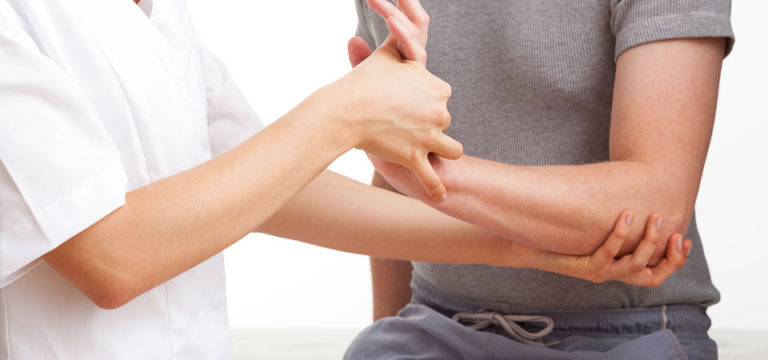
Our hand and elbow rehabilitation program covers treatment for all injuries involving the hands, wrists and elbows, including sprains, strains, tendon issues, arthritis, amputation and nerve problems. After performing an evaluation of the source and severity of your injury, we’ll create a personalized healing plan to address your specific needs. Throughout your therapy sessions, we’ll help you regain strength and range of motion with the essential goal of restoring daily usages. Once that’s completed, we’ll tailor a home exercise program for you in order to maintain and build your hand, wrist and elbow functionality.
Tendonitis of the Elbow (Tennis Elbow) – Despite its name, many who experience tennis elbow don’t play the sport at all. The condition simply refers to elbow pain caused by overused arm, forearm or hand muscles. Discomfort may also spread as far down as the wrist.
At Directions, we can effectively treat your tennis elbow by customizing a series of manual therapy exercises that will normalize joint and soft connective tissue mobility – including nerves and fascia – and strengthen the arm and hand muscles, alleviating pain and increasing the elbow’s flexibility and range of motion.
Carpal tunnel syndrome – The carpal tunnel is a small hole through which the median nerve (which controls feeling in your thumb and first three fingers) and multiple tendons move from the forearm to the hand. Carpal tunnel syndrome is numbness, tingling, weakness or other issues with your fingers or hand due to pressure on the median. A prevalent condition, symptoms of carpal tunnel include: aching, numbness or pain in your forearm or wrist; pain that worsens when using your hand or wrist; the constant sensation that your hand has “pins and needles” or has “fallen asleep”; finger stiffness
Shoulder Therapy – Chronic pain, injury or post-operative care are just a few of the reasons patients seek physical therapy for the shoulder area. All shoulder injuries, especially sports-related ones, require accurate and thorough treatment.
Shoulder Pain: Another prevalent condition, shoulder pain may originate from the joint itself or any of the surrounding muscles or tendons in the shoulder area. It’s often a result of:
Rotator Cuff Tendonitis: the rotator cuff is a group of muscles and tendons that support shoulder movement; pain occurs when it becomes inflamed or irritated. Athletes playing sports requiring them to extend their arm over the head – like tennis, swimming or baseball – often develop this condition. It can also be related to nerve impingement. In addition, we see this injury often with people who work long hours at their desks, with minimal movement throughout the day.
Biceps Tendonitis: An inflammation of the main tendon that attaches the top of the bicep to the shoulder, it can occur gradually due to everyday wear and tear or happen suddenly, as the result of direct injury.
Shoulder Bursitis: The shoulder bursae are fluid-filled sacs that cushion the bones, muscles and tendons near the shoulder joint. Pain occurs when these bursae become pinched.
Frozen Shoulder: Also known as adhesive capsulitis, frozen shoulder is characterized by stiffness or pain in the shoulder joint. Often times, the cause of frozen shoulder is unknown, although those at risk include patients recovering from a medical condition that prevents arm movement, like stroke or a mastectomy.
Shoulder Fracture: The medical term for a broken shoulder bone, shoulder fractures often occur as the result of a bad fall. If the fracture does not heal properly, deformity can occur.
The good news is that physical therapy can be greatly effective in treating shoulder pain. We’ll begin by stabilizing the joint, which will ease soreness and irritation. After that, we’ll start you on a personalized manual therapy and stretching and strengthening regimen that will elongate your muscles and increase flexibility. Our end goal: restoring complete range of shoulder motion.
Osteoarthritis
Osteoarthritis, the most common type of arthritis, occurs when the protective cartilage at the end of your bones wears down over time. Although it can affect any joint in your body, it occurs more frequently in the hands, knees, hips and spine. Symptoms of osteoarthritis include pain, tenderness, stiffness or loss of flexibility in the joint. Bone spurs, extra bits of bone that feel like hard lumps, may form around the joint as well. Unfortunately, there’s no cure for osteoarthritis. Physical therapy, however, can help alleviate pain and slow downs its symptoms and progression.
And more.
Physical therapy can be effective in helping you perform normal activities again. At Directions, we’ll perform an evaluation of your condition, then design a program that addresses the symptoms and limitations. Treatment will include exercises that improve the strength and flexibility of the muscles to heal your current pain and prevent future discomfort from reoccurring.
(C) Copyright 2023 - Directions Physical Therapy & Acupuncture. All rights reserved.
